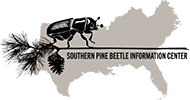Abstract
We estimated annual timber growth, removals, and mortalities under various scenarios of the spread of emerald ash borer (Agrilus planipennis Fairmaire; EAB) within Texas. Future annual ash EAB-induced mortalities were simulated to follow either a normal or beta distribution over 25, 50, or 75 years, with five percent of the original inventory remaining at the conclusion of each projection. Discounted present values of future ash growth, harvests, mortalities, salvage, and beginning and ending annual inventories were calculated, and economic impacts to timber receipts were determined from average real prices. The present net effects of timber product output, mortalities, and salvage resulted in benefits ranging from lows of (delivered/stumpage) $37.6/$12.8 million over 25 years when assuming a normal distribution to highs of $247.8/$97.2 million over 75 years under a beta distribution. Salvage intensity exceeded mortality accumulation by a factor of at least 2.00. Regardless of length chosen, mortality that skewed toward later years led to lower discounted volumes and less value lost to EAB. Results were sensitive to discount rate selection (constant, increasing, distributional) with the constant and increasing rates having the most similar results. Longer time horizons led to far smaller losses of overall economic returns allowing more typical harvest management despite EAB.
Keywords
Agrilus planipennis, bark beetle, beta distribution, Fraxinus, normal distribution, timber salvage
To read the full article please visit the link below:
VanderSchaaf, Curtis L., T. Eric McConnell, and Shaun M. Tanger. 2021. “Estimated Impacts of Emerald Ash Borer on Ash Timber Supply in Texas, USA.” Journal of Forestry 119 (1): 45–61. https://doi.org/10.1093/jofore/fvaa043..
